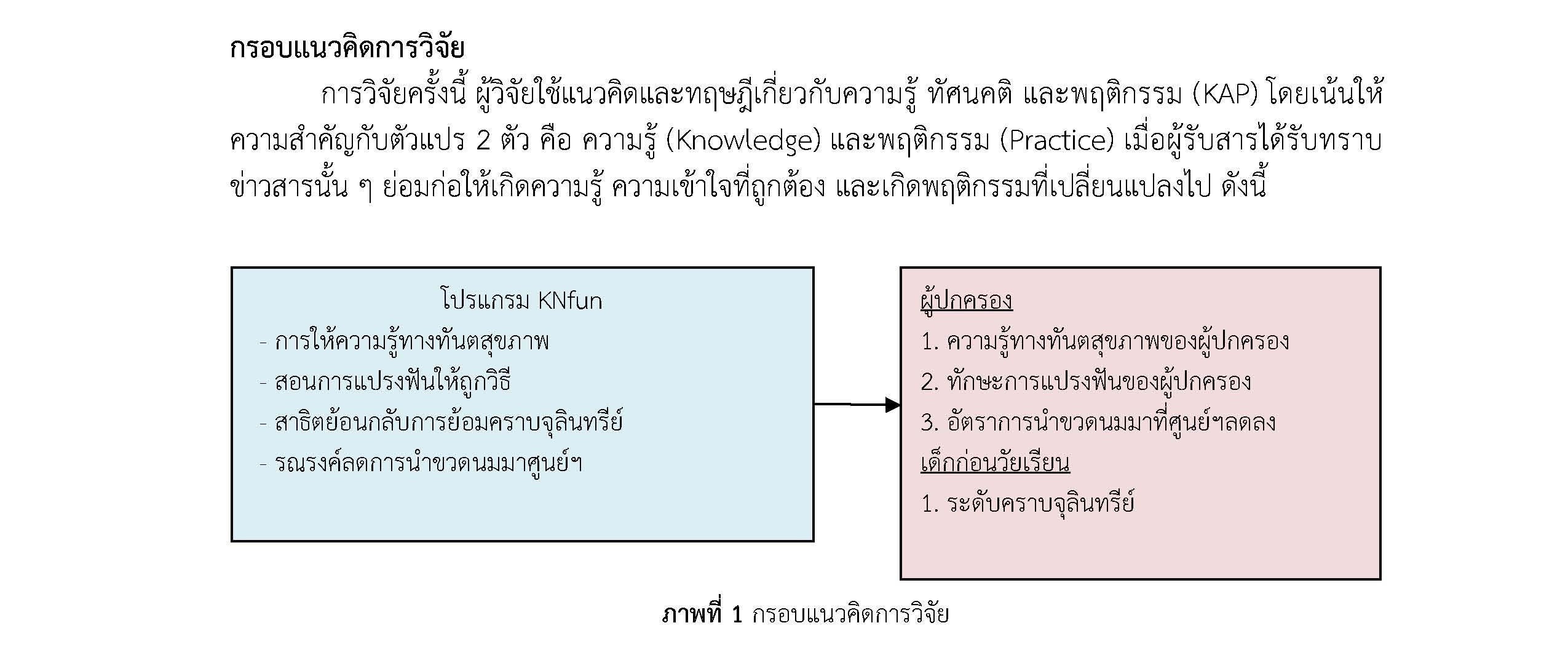The Effects of Using the KNfun Model on Oral Health Knowledge and Behavior Among Parents; and on Dental Plaque Among Preschool Children
Keywords:
Dental Health Knowledge, Brushing Skills, Plaque, Preschool ChildrenAbstract
The objectives of the one-group pretest-posttest design were to examine the effects of using the KNfun program on the oral health knowledge and behavior of parents and the dental plaque levels of preschool children in the Preschool Child Development Centers in Songkla province. Participants were 30 patients and preschool children in the Child Development Centers. The research instruments were the KNfun program, an oral health knowledge questionnaire, a toothbrushing skills assessment form, a plaque control record, and a baby bottle milk feeding record. The Index of Item-Objective Congruence of an oral health knowledge and a toothbrushing skills assessment form was between 0.67-1.00. The reliability of these questionnaires was 0.62. Data were analyzed using descriptive statistics and the paired sample t-test.
The results showed that after using the KNfun program, the mean score of parents’ oral health knowledge and toothbrushing skills were significantly higher than before attending the program (p-value < 0.001). The plaque index score of children was significantly lower than before attending the program (p-value < 0.001). The rate of preschool children bringing a bottle of milk to the child development center dropped from 74.1 % to 0 %. Therefore, the KNfun program can reduce the risk of caries among preschool children. The KNfun program should be continued in order to address the prevalence of dental caries among preschool children.
References
เกตุวดี เจือจันทร์, อิชยา สินไชย, อรวรรณ นามมนตรี, อโนชา ศิลาลัย และหฤทัย สุขเจริญโกศล. (2559). พฤติกรรมการดูแลสุขภาพช่องปากเด็กของผู้ปกครองและสภาวะฟันผุของเด็กก่อนวัยเรียน อำเภอแก่งคอย จังหวัดสระบุรี. วารสารสุขภาพและการศึกษาพยาบาล, 22(1), 5-17.
จุฑามาส มณีโชติ. (2559). ผลของโปรแกรมการสร้างเสริมทันตสุขภาพต่อพฤติกรรมการแปรงฟัน การเลิกขวดนมของผู้ดูแลเด็กและฟันผุที่เพิ่มขึ้นของเด็กอายุ 9-18 เดือน ในอำเภอหาดใหญ่ จังหวัดสงขลา. วิทยานิพนธ์ วิทยาศาสตรมหาบัณฑิต สาขาวิชาวิทยาศาสตร์สุขภาพช่องปาก มหาวิทยาลัยสงขลานครินทร์.
นฤชิต ทองรุ่งเรืองชัย และพรรณี บัญชรหัตถกิจ. (2555). ปัจจัยที่มีความสัมพันธ์กับพฤติกรรมการแปรงฟัน ให้เด็กอายุ 1-5 ปีของผู้ปกครองในเขตอำเภอโนนสัง จังหวัดหนองบัวลำภู. สืบค้นเมื่อ 10 สิงหาคม 2562 จาก http://www.thaiscience.info/journals/Article/SRMJ/10899636.pdf.
นัยนา ณีศะนันท์. (2559). นมแม่สารอาหาร พัฒนาการ การเจริญเติบโต. ชุดทบทวนวรรณกรรมนมแม่ ชุดที่ 3. กรุงเทพฯ: มูลนิธิศูนย์นมแม่แห่งประเทศไทย.
ละอองดาว วงศ์อำมาตย์, กุลชญา ลอยหา และเผ่าไทย วงศ์เหลา. (2563). ประสิทธิผลการประยุกต์ใช้ทฤษฎีความสามารถตนเองร่วมกับแรงสนับสนุนทาง สังคมในการปรับเปลี่ยนพฤตกิรรมการป้องกันโรคฟันผุของเด็กนักเรียน ประถมศึกษาปีที่ 5-6 อำเภอบุณฑริก จังหวัดอุบลราชธานี. วารสารวิจัยสาธารณสุขศาสตร์ มหาวิทยาลัยราชภัฏอุบลราชธานี, 9(2), 55-68.
ลักขณา อุ้ยจิรากุล. (2556). ความสัมพันธ์ระหว่างพฤติกรรมการเลี้ยงดูและการเกิดโรคฟันผุในเด็กเล็กในจังหวัดสระแก้ว. วิทยานิพนธ์ปริญญาวิทยาศาสตรมหาบัณฑิต สาขาวิชาการวิจัยทางทันตเเพทย์บัณฑิตวิทยาลัย มหาวิทยาลัยขอนแก่น.
สำนักงานทันตสาธารณสุข กรมอนามัย กระทรวงสาธารณสุข. (2560). รายงานผลการสำรวจสภาวะทันตสุขภาพระดับประเทศ ครั้งที่ 8 ประเทศไทย พ.ศ. 2556-2560. สืบค้นเมื่อ 10 สิงหาคม 2563 จาก http://www.dent.chula.ac.th/upload/news/791/file_1_5834.pdf.
สำนักงานสาธารณสุขจังหวัดสงขลา. (2562). รายงานผลการสำรวจสภาวะทันตสุขภาพ จ.สงขลา ปีพ.ศ.2562. สืบค้นเมื่อ 10 สิงหาคม 2562 จาก http://www.skho.moph.go.th/skho/newsget.php?newsid=76.
สิริลักษณ์ รสภิรมย์. (2556). ประสิทธิผลของโปรแกรมทันตสุขศึกษาโดยประยุกต์ใช้ทฤษฎีความสามารถตนเองที่มีต่อพฤติกรรมทันตสุขภาพของนักเรียนชั้นประถมศึกษาปีที่ 4 อำเภอเมือง จังหวัดนครปฐม. วารสารคณะพลศึกษา, 16(1), 145–157.
Cohen, J. (1977). Statistical power analyses for the behavioral sciences. Hillsdale, NJ: Lawrence Earlbaum.
Dye, B. A., Mitnik, G. L., Iafolla, T. J., & Vargas, C. M. (2017). Trends in dental caries in children and adolescents according to poverty status in the United States from 1999 through 2004 and from 2011 through 2014. Journal of the American Dental Association (1939), 148(8), 550–565.e7. https://doi.org/10.1016/j.adaj.2017.04.013.
Kazeminia, M., et al. (2020). Dental caries in primary and permanent teeth in children's worldwide, 1995 to 2019: A systematic review and meta-analysis. Head & Face Medicine, 16(1), 22. https://doi.org/10.1186/s13005-020-00237-z.
Niederman, R., Sullivan, T. M., Weiss, D., Morhart, R., Robbins, W., & Maier, D. (1981). Oral Hygiene Skill Achievement Index II. Journal of Periodontology, 52(3), 150–154. https://doi.org/10.1902/jop.1981.52.3.150.
Stallard, R. E., Volpe, A. R., Orban, J. E., & King, W. J. (1969). The effect of an antimicrobial mouth rinse on dental plaque, calculus and gingivitis. Journal of Periodontology, 40(12), 683–694. https://doi.org/10.1902/jop.1969.40.12.683.

Downloads
Published
How to Cite
Issue
Section
License
Copyright (c) 2022 Journal of Nursing and Public Health Research

This work is licensed under a Creative Commons Attribution-NonCommercial-NoDerivatives 4.0 International License.
1. บทความหรือข้อคิดเห็นใด ๆ ที่ปรากฏในวารสารวิจัยการพยาบาลและการสาธารณสุข ที่เป็นวรรณกรรมของผู้เขียน บรรณาธิการไม่จำเป็นต้องเห็นด้วย
2. บทความที่ได้รับการตีพิมพ์ถือเป็นลิขสิทธิ์ของ วารสารวิจัยการพยาบาลและการสาธารณสุข








